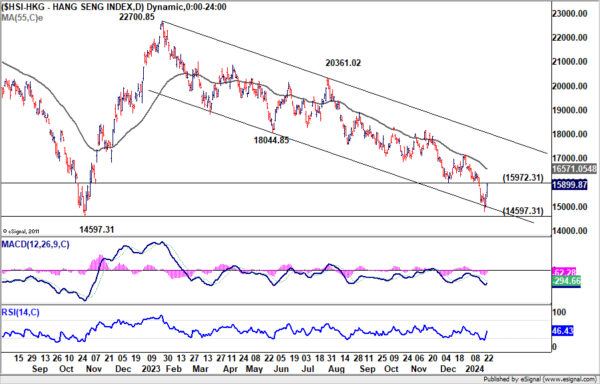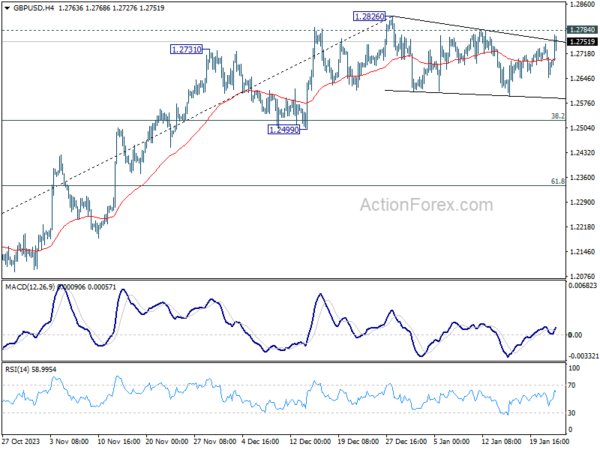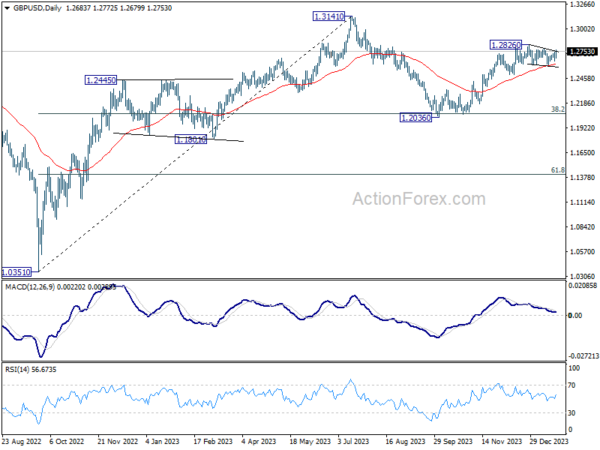Sterling Rises Following Encouraging UK PMI Data, Dollar Weakens Across The Board
Sterling rises notably against Euro and Dollar today, buoyed by encouraging UK PMI data that pointed to a strong start for the year with renewed growth momentum. More importantly, this data suggests that BoE might need to delay its rate cut plans, as inflationary pressures could potentially resurge due to supply disruptions in the Red Sea. Simultaneously, Eurozone’s PMI data, while less optimistic, also supports ECB hawks’ stance against premature rate cuts, with price indicators suggesting sustained inflationary pressures.
Conversely, Dollar softens broadly in the wake of slump in US 10-year yield. This decline comes amidst an uptick in market sentiment in Asia, following the People’s Bank of China’s decision to cut the reserve ratio requirement by 50 basis points. This move is set to inject approximately CNY 1T into the economy, aiming to bolster long-term capital. Nevertheless, Australian and New Zealand Dollars have not shown significant responses to this development. Meanwhile, Canadian Dollar is trading softly as market participants await BoC interest rate decision, where maintaining the current rate is widely anticipated.
From a technical perspective, a key focus for the remainder of the week will be the durability of the shift in sentiment in Hong Kong and China. The immediate point of interest lies at 15972.31 support-turned-resistance in HSI after today’s 3.56% gain. Decisive break there will raise the chance of bottoming ahead of 14597.31 (2022 low). That would at least set up further rebound to 55 D EMA (now at 16571.05), or even further to channel resistance at around 18000 later in the quarter.
In Europe, at the time of writing, FTSE is up 0.35%. DAX is up 1.41%. CAC is up 0.88%. UK 10-year yield is up 0.0192 at 4.006. Germany 10-year yield is down -0.0247 at 2.330. Earlier in Asia, Nikkei fell -0.80%. Hong Kong HSI rose 3.56%. China Shanghai SSE rose 1.80%. Singapore Strait Times rose 0.58%. Japan 10-year JGB yield rose 0.0856 to 0.723.
UK PMI composite rises to 52.5, may delay BoE rate cut
UK PMI Manufacturing rose from 46.2 to 47.3 in January, a 9-month high. PMI Services rose from 53.4 to 53.8, an 8-month high. PMI Composite rose from 52.1 to 52.5, a 7-month high.
Chris Williamson, Chief Business Economist at S&P Global Market Intelligence, noted that UK business activity growth has “accelerated for a third straight month”. He described this as a “promising start” to the year.
According to the survey data, UK economy is expected to grow at a quarterly rate of 0.2% after a flat fourth quarter, thereby “skirting recession and showing signs of renewed momentum”.
However, Williamson highlighted a crucial implication of this unexpected growth strength in January, which could lead BoE to reconsider the timing of any anticipated interest rate cuts.
This reassessment is particularly pertinent in light of supply disruptions in the Red Sea, which have reignited inflationary pressures in the manufacturing sector. Williamson indicated that inflation is expected to remain stubbornly in the 3-4% range in the near term.
Bundesbank report warns of German economy’s vulnerability to China’s economic woes
In its latest monthly report, Bundesbank issued a cautionary message about China’s current economic struggles and their potential impact on Germany. The report notes that China is grappling with “significant economic problems,” and the relationship between China and Western industrial nations has “noticeably deteriorated recently.” Such geopolitical risks, if they materialize, could have severe repercussions for the German economy.
The Bundesbank essay posits that “an economic crisis in China of the kind that has occurred in other countries in the past following a correction of excessive credit growth would probably be bearable for the German economy.” However, the impact would not be negligible, with projections indicating that Germany’s real GDP could be -0.7% lower in the first year of a potential crisis in China, and then -1% in the second year.
The report also highlights a more severe scenario: “However, an abrupt decoupling, for example as a result of a geopolitical crisis, would have a significantly greater impact on German industry in particular.” In such an event, German companies with direct involvement in China could face considerable losses in sales and profit. Industries like automotive, mechanical engineering, electronics, and electrical engineering are particularly reliant on Chinese demand.
Moreover, Bundesbank emphasizes the broader risks associated with the close economic ties between Germany and China: “the close real economic ties between Germany and China also pose considerable risks for the German financial system.”
Eurozone’s PMI composite climbs to 47.9, price data echo ECB hawks’ caution
Eurozone PMI Manufacturing rose from 44.4 to 46.6 in January, a 10-month high. However, PMI services fell from 48.8 to 48.4. PMI Composite rose from 47.6 to 47.9, a 6-month high.
Cyrus de la Rubia, Chief Economist at Hamburg Commercial Bank, noted that Eurozone’s manufacturing sector is experiencing a “widespread easing of the downward trajectory witnessed in the past year”. He highlights that this positive trend is “evident across key indicators such as output, employment, and new orders.”
While the services sector is contracting, de la Rubia points out that the contraction is “currently moderate”. He also notes a “silver lining,” as there is an increase in companies expanding their workforce, which indicates a degree of optimism in the market.
De la Rubia’s observation that PMI price indicators are in line with the sentiments of the hawks within ECB. He states they are “all about shouting ‘hold your horses'”, emphasizing a need for a measured approach and advising against rushing into early rate cuts.
Germany PMI Manufacturing rose from 43.3 to 45.4 in January, an 11-month high. PMI Services fell from 49.3 to 47.6, a 5-month low. PMI Composite fell from 47.4 to 47.1, a 3-month low.
France PMI Manufacturing rose from 42.1 to 43.2 in January. PMI Services fell from 45.7 to 45.0. PMI Composite fell from 44.8 to 44.2.
Japan’s PMI shows modest growth, manufacturing still in contraction
Japan’s PMI Manufacturing rose fractionally from 47.9 to 48.0 in January, below expectation of 48.2. Manufacturing remained in contraction for the eighth consecutive months. PMI Services rose from 5.15 to 52.7. PMI Composite rose from 50.0 to 51.1.
Usamah Bhatti, Economist at S&P Global Market Intelligence, noted that while “modest” the private sector is having the strongest growth since September. However, there was disparity between the sectors, with services reaching a four-month high, while manufacturing marked its eighth consecutive month of contraction.
Regarding inflation, Bhatti said input price inflation “remains high historically”. But output inflation eased to its “lowest since February 2022”. This indicates that while input costs are still elevated, businesses are not passing these costs fully onto consumers.
Japan’s exports exceed JPY 1T in 2023, US reclaims top export destination
Japan’s exports rose 9.8% yoy to JPY 9648B in December, marking the biggest increase in a year. This boost was largely driven by 20.4% yoy jump in exports to US, predominantly from the automotive sector, while exports to Europe climbed by 10.3% yoy. Notably, shipments to China saw 9.6% yoy rise, registering their first growth in 13 months, primarily led by chip-making equipment. In contrast, imports declined -6.8% yoy to JPY 9586B. Consequently, trade balance turned positive, recording JPY 62.1B surplus.
Analyzing the whole year, Japan’s trade deficit in 2023 more than halved to JPY -9.29T from the previous year. The country’s total exports rose by 2.8% to reach JPY 100.89T , surpassing the JPY 100T mark for the first time ever. Meanwhile, total imports saw -7.0% decrease to JPY 110.18T.
A significant shift was observed in Japan’s export destinations in 2023. US reclaimed its position as the largest recipient of Japanese exports by value for the first time in four years, surpassing China. Exports to US reached JPY 20.27T, showing 11.0% increase, while exports to China decreased by -6.5% to JPY 17.76T.
New Zealand CPI slows to 0.5% qoq, 4.7% yoy in Q4
New Zealand CPI rose 0.5% qoq in Q4, down from 1.8% qoq in Q3, matched expectations. Tradeable inflation turned negative to -0.2% qoq, from 1.8% qoq. Non-tradeable inflation slowed to 1.1% qoq, down from 1.7% qoq.
Annually, CPI slowed from 5.6% yoy to 4.7% yoy, matched expectations. Tradeable inflation slowed from 4.7% yoy to 3.0% yoy. non-tradeable inflation also slowed from 6.3% yoy to 5.9% yoy.
“While this is the smallest annual rise in the CPI in over two years, it remains above the Reserve Bank of New Zealand’s target range of 1 to 3 percent,” consumers prices senior manager Nicola Growden said.
Australia’s PMI manufacturing Hits 11-month high, services Lagging
Australia PMI Manufacturing rose from 47.6 to 50.3 in January, back in expansion, and a 11-month high. PMI Services rose slightly from 47.1 to 47.9, a 3-month high. PMI Composite rose from 46.9 to 48.1, a 4-month high, but still in contraction.
Warren Hogan, Chief Economic Advisor at Judo Bank noted the PMI data indicates a that the economy remains on RBA’s “narrow path” for soft landing. He highlights the manufacturing sector’s rebound as a key factor in mitigating broader economic downturn risks.
Despite the general economic slowdown, Hogan observes that labor demand remains unexpectedly robust, differing from past economic cycles. However, he cautions that inflation pressures are still high, pointing out, “Input and output price indexes remain at levels suggesting CPI inflation is above the RBA’s target range.”
GBP/USD Mid-Day Outlook
Daily Pivots: (S1) 1.2642; (P) 1.2694; (R1) 1.2740; More…
Immediate focus is now on 1.2784 minor resistance in GBP/USD. Decisive break there will suggest that consolidation pattern from 1.2826 has completed. Further rise should be seen through 1.2826 to resume the rise from 1.2036. Next target will be 1.3141 high. in case of another fall, downside should be contained above 1.2499 support to bring rebound.
In the bigger picture, price actions from 1.3141 medium term top are seen as a corrective pattern to up trend from 1.0351 (2022 low). Rise from 1.2036 is seen as the second leg that’s in progress. Upside should be limited by 1.3141 to bring the third leg of the pattern. Meanwhile, break of 1.2499 support will argue that the third leg has already started for 38.2% retracement of 1.0351 (2022 low) to 1.3141 at 1.2075 again.
Economic Indicators Update
| GMT | Ccy | Events | Actual | Forecast | Previous | Revised |
|---|---|---|---|---|---|---|
| 21:45 | NZD | CPI Q/Q Q4 | 0.50% | 0.50% | 1.80% | |
| 21:45 | NZD | CPI Y/Y Q4 | 4.70% | 4.70% | 5.60% | |
| 22:00 | AUD | Manufacturing PMI Jan P | 50.3 | 47.6 | ||
| 22:00 | AUD | Services PMI Jan P | 47.9 | 47.1 | ||
| 23:30 | AUD | Westpac Leading Index M/M Dec | 0.00% | 0.10% | ||
| 23:50 | JPY | Trade Balance (JPY) Dec | -0.41T | -0.45T | -0.41T | -0.35T |
| 00:30 | JPY | Manufacturing PMI Jan P | 48 | 48.2 | 47.9 | |
| 00:30 | JPY | Services PMI Jan P | 52.7 | 51.5 | ||
| 08:15 | EUR | France Manufacturing PMI Jan P | 43.2 | 42.5 | 42.1 | |
| 08:15 | EUR | France Services PMI Jan P | 45 | 46 | 45.7 | |
| 08:30 | EUR | Germany Manufacturing PMI Jan P | 45.4 | 43.7 | 43.3 | |
| 08:30 | EUR | Germany Services PMI Jan P | 47.6 | 49.5 | 49.3 | |
| 09:00 | EUR | Eurozone Manufacturing PMI Jan P | 46.6 | 44.8 | 44.4 | |
| 09:00 | EUR | Eurozone Services PMI Jan P | 48.4 | 49.1 | 48.8 | |
| 09:30 | GBP | Manufacturing PMI Jan P | 47.3 | 46.7 | 46.2 | |
| 09:30 | GBP | Services PMI Jan P | 53.8 | 53.5 | 53.4 | |
| 14:45 | CAD | BoC Interest Rate Decision | 5.00% | 5.00% | ||
| 14:45 | USD | Manufacturing PMI Jan P | 47.7 | 47.9 | ||
| 14:45 | USD | Services PMI Jan P | 51.1 | 51.4 | ||
| 15:30 | USD | Crude Oil Inventories | -1.2M | -2.5M | ||
| 15:30 | CAD | BoC Press Conference |
The Penny Drops: Understanding The Complex World Of Small Stock Machinations
Micro-cap stocks, often overlooked by mainstream investors, have recently garnered significant attention due to rising c... Read more
Current Economic Indicators And Consumer Behavior
Consumer spending is a crucial driver of economic growth, accounting for a significant portion of the US GDP. Recently, ... Read more
Skepticism Surrounds Trump's Dollar Devaluation Proposal
Investors and analysts remain skeptical of former President Trump's dollar devaluation plan, citing tax cuts and tariffs... Read more
Financial Markets In Flux After Biden's Exit From Presidential Race
Re-evaluation of ‘Trump trades’ leads to market volatility and strategic shifts.The unexpected withdrawal of Joe Bid... Read more
British Pound Poised For Continued Gains As Wall Street Banks Increase Bets
The British pound is poised for continued gains, with Wall Street banks increasing their bets on sterling's strength. Th... Read more
China's PBoC Cuts Short-Term Rates To Stimulate Economy
In a move to support economic growth, the People's Bank of China (PBoC) has cut its main short-term policy rate for the ... Read more




